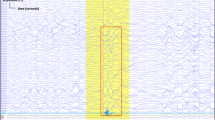Abstract
The aim of this study is to investigate the electromagnetic sources of epileptic activity in two patients with juvenile myoclonus epilepsy (JME). The first patient was a 22-year old female with JME diagnosis by the age of 17 years old. Her initial EEG recording showed characteristic paroxysmal generalized activity with polyspike–wave complexes. She was on remission for 9 months. The second patient was a 29-year old male with JME diagnosis by the age 18 of years old. He showed an EEG recording with generalized spike-wave complexes of 3.5–4 Hz and presented a great improvement after therapeutic treatment. The MRI examinations for both patients did not disclose any focal lesions or areas of abnormal signal intensity or enhancement by contrast media. Magnetoencephalography (MEG) was recorded with a 122-channel whole-head system, 5 years after the disease onset for the first patient and 11 years for the second patient. For the first patient dipolar sources of MEG paroxysmal activity were localised at the vermis with extension up to the occipital region, whereas, for the second patient dipolar sources of MEG paroxysmal activity were localised at the cerebellar area (vermis and hemisphere). Implication of the cerebellum in JME, as suggested by MEG data in this study, is in accordance with previous reports employing functional MRI or cerebral blood flow evaluation in JME.


Similar content being viewed by others
References
Aghakhani Y, Bagshaw AP, Bénar CG, Hawco C, Andermann F, Dubeau F, Gotman J (2004) fMRI activation during spike and wave discharges in idiopathic generalized epilepsy. Brain 127(Pt 5):1127–1144
Alfradique I, Vasconcelos MM (2007) Juvenile myoclonic epilepsy. Review. Arq Neuropsiquiatr 65:1266–1271
Altindag E, Kara B, Baykan B, Terzibasioglu E, Sencer S, Onat L, Sı M (2008) MR spectroscopy findings in Lafora disease. J Neuroimaging [Epub ahead of print]
Antoniou PE, Anninos PA, Piperidou H, Adamopoulos A, Kotini A, Koukourakis MI, Sivridis E (2004) Non linear analysis of magnetoencephalographic signals as a tool for assessing malignant lesions of the brain: first results. Brain Topogr 17:117–123
Arzimanoglou A, Guerrini R, Aicardi J (2004) Epilepsies with predominantly myoclonic seizures. In: Arzimanoglou A, Guerrini R, Aicardi J (eds) Aicardis epilepsy in children. Lippincott Williams & Wilkins, Philadelphia, pp 58–80
Forss N, Silén T, Karjalainen T (2001) Lack of activation of human secondary somatosensory cortex in Unverricht–Lundborg type of progressive myoclonus epilepsy. Ann Neurol 49:90–97
Joo EY, Tae WS, Hong SB (2008) Cerebral blood flow abnormality in patients with idiopathic generalized epilepsy. J Neurol 255:520–525
Kälviäinen R, Khyuppenen J, Koskenkorva P, Eriksson K, Vanninen R, Mervaala E (2008) Clinical picture of EPM1–Unverricht–Lundborg disease. Epilepsia 49:549–556
Kotini A, Anninos P (2002) Detection of non-linearity in schizophrenic patients using magnetoencephalography. Brain Topogr 15:107–113
Kotini A, Anninos P, Adamopoulos A, Prassopoulos P (2005) Low-frequency MEG activity and MRI evaluation in Parkinson’s disease. Brain Topogr 18:59–63
Liu Y, Yang X, Liao W, Liu L, Yan B, Lin X, Xi J, Xu H, Cheng H, Zhou D (2007) Study on interictal epileptiform discharges in juvenile myoclonic epilepsy patient with EEG-fMRI. Sheng Wu Yi Xue Gong Cheng Xue Za Zhi 24:748–751
Lopes Da Silva FH (2005) What is magnetoencephalography and why it is relevant to neurosurgery? In: Pickard JD, Akalan N, Di Rocco C et al (eds) Advances and technical standards in neurosurgery, vol 30. Springer-Verlag, Wien, pp 51–67
Pedersen SB, Petersen KA (1998) Juvenile myoclonic epilepsy: clinical and EEG features. Acta Neurol Scand 97:160–163
Sousa NAC, Sousa PS, Garzon E, Sakamoto AC, Yacubian EMT (2005) Juvenile myoclonic epilepsy: analysis of factors implied in delayed diagnosis and prognosis after clinical and electroencephalographical characterization. J Epilepsy Clin Neurophysiol 11:7–13
Striano P, Caranci F, Di Benedetto R, Tortora F, Zara F, Striano S (2008) (1)H-MR spectroscopy indicates prominent cerebellar dysfunction in benign adult familial myoclonic epilepsy. Epilepsia [Epub ahead of print]
Tae WS, Joo EY, Han SJ, Lee KH, Hong SB (2007) CBF changes in drug naive juvenile myoclonic epilepsy patients. J Neurol 254:1073–1080
Uesaka Y, Terao Y, Ugawa Y, Yumoto M, Hanajima R, Kanazawa I (1996) Magnetoencephalographic analysis of cortical myoclonic jerks. Electroencephalogr Clin Neurphysiol 99:141–148
Verrotti A, Salusti B, Trotta D, Madonna L, Chiarelli F, Pizzella V (2003) Epilepsy evaluation by electroencephalography and magnetoencephalography in Lafora-body disease: a case report. Acta Paediatr 92:1218–1222
Author information
Authors and Affiliations
Corresponding author
Rights and permissions
About this article
Cite this article
Kotini, A., Mavraki, E., Anninos, P. et al. Magnetoencephalographic Findings in Two Cases of Juvenile Myoclonus Epilepsy. Brain Topogr 23, 41–45 (2010). https://doi.org/10.1007/s10548-009-0114-5
Received:
Accepted:
Published:
Issue Date:
DOI: https://doi.org/10.1007/s10548-009-0114-5




